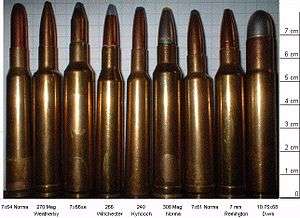.270 Weatherby Magnum
The .270 Weatherby Magnum was the first belted magnum based on the .300 H&H Magnum to be developed by Roy Weatherby in 1943.[2] The cartridge is short enough to function in standard-length long actions with a brass length of 2.549" or 64.74mm and an overall length of about 3.295".[2] It has the characteristic double-radius shoulders and is necked down to accommodate the .277 in bullets. Like most Weatherby cartridges, the .270 Weatherby was standardized by the Small Arms and Ammunitions Manufacturers Institute in 1994, and it has a SAAMI maximum pressure limit of 62,500 psi. The first Weatherby cartridge to be used in Africa was the .270 Weatherby on a jackal on June 8, 1948.[3]
| .270 Weatherby Magnum | ||||||||||||||||||||
|---|---|---|---|---|---|---|---|---|---|---|---|---|---|---|---|---|---|---|---|---|
 .270 Weatherby 2nd from left | ||||||||||||||||||||
| Type | Rifle / Hunting | |||||||||||||||||||
| Place of origin | USA | |||||||||||||||||||
| Production history | ||||||||||||||||||||
| Designer | Roy Weatherby | |||||||||||||||||||
| Designed | 1943 | |||||||||||||||||||
| Manufacturer | Weatherby | |||||||||||||||||||
| Specifications | ||||||||||||||||||||
| Parent case | .300 H&H Magnum | |||||||||||||||||||
| Case type | Belted, bottleneck | |||||||||||||||||||
| Bullet diameter | .277 in (7.0 mm) | |||||||||||||||||||
| Neck diameter | .303 in (7.7 mm) | |||||||||||||||||||
| Shoulder diameter | .492 in (12.5 mm) | |||||||||||||||||||
| Base diameter | .512 in (13.0 mm) | |||||||||||||||||||
| Rim diameter | .531 in (13.5 mm) | |||||||||||||||||||
| Rim thickness | .220 in (5.6 mm) | |||||||||||||||||||
| Case length | 2.55 in (65 mm) | |||||||||||||||||||
| Overall length | 3.25 in (83 mm) | |||||||||||||||||||
| Rifling twist | 1-10" | |||||||||||||||||||
| Primer type | Large rifle magnum | |||||||||||||||||||
| Ballistic performance | ||||||||||||||||||||
| ||||||||||||||||||||
| Test barrel length: 26" Source(s): Accurate Powder [1] | ||||||||||||||||||||
Performance
Given its higher pressure and larger case which holds more powder than the .270 Winchester, the .270 Weatherby has about 200 ft/s faster performance with any particular bullet weight. This performance comes at the cost of more recoil and barrel heat. In addition, a long barrel is necessary to take advantage of extra powder to gain maximum velocity. The cartridge is excellent at long-range hunting, but is not well suited to high-volume shooting such as varmint hunting.[4]
For those handloading their own cartridges, this is an easy round to load. It does best with full-power loads and is not well-suited for reduced loads.[4][5] Ed Weatherby, son of Roy Weatherby says that the .270 Weatherby is his favorite caliber. As he puts it, there just isn't a better long-range deer caliber. He goes on to mention that it is also quite effective for elk, and pronghorn.[3]
References
- ".270 Weatherby data from Accurate Powder" (PDF). Archived from the original (PDF) on 2007-09-28. Retrieved 2007-08-18.
- Bullets, Speer (2009). Speer Bullets Reloading Manual #14. Speer. p. 340. ISBN 978-0-9791860-0-4.
- Nosler, Inc. (2002). Nosler Reloading Guide (5th ed.). Bend, OR, USA: Nosler, Inc. pp. 219–224.
- Barnes, Frank C. (2006) [1965]. Skinner, Stan (ed.). Cartridges of the World (11th ed.). Iola, WI, USA: Gun Digest Books. p. 43. ISBN 0-89689-297-2.
- Ackley, P.O. (1927) [1962]. Handbook for Shooters & Reloaders. vol I (12th Printing ed.). Salt Lake City, Utah: Plaza Publishing. pp. 384, 385. ISBN 978-99929-4-881-1.
